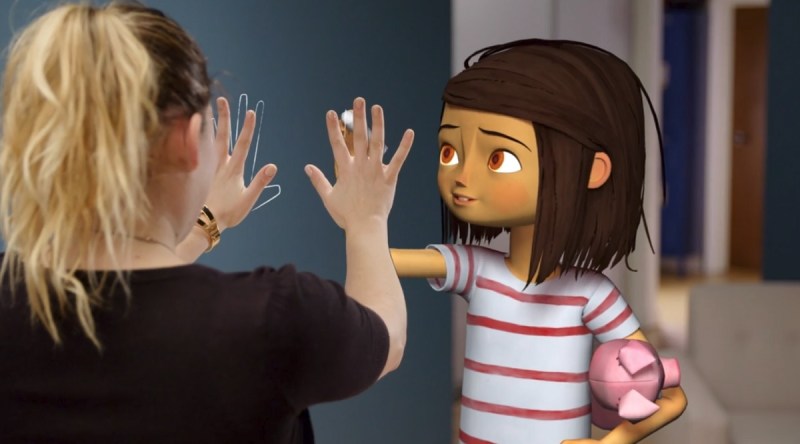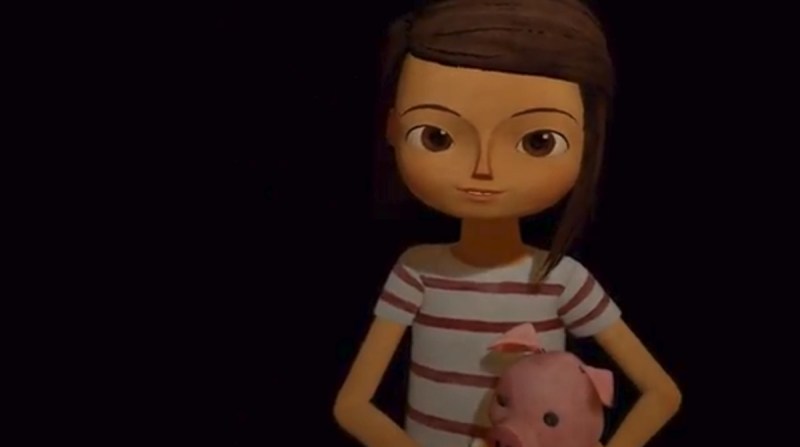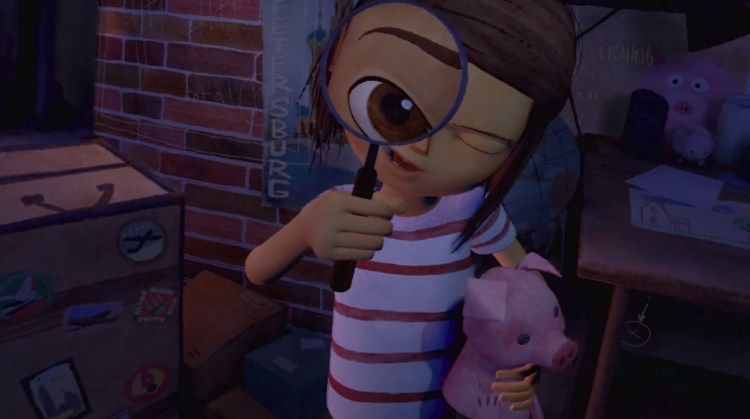GamesBeat: Are you acknowledging that you got the funding from Oculus?
Saatchi: Yeah, we’re funded by Oculus. Or to be clear, the project is funded by Oculus. It’s not an equity piece. The Wolves in the Walls project is funded by Oculus.
GamesBeat: It seems like a lot of the material I’ve seen so far fits the length I’ve seen. As people get more ambitious, do you think people can build up to two-hour experiences? I don’t know that I would want a full two hours of Henry, for example.
Saatchi: In part it’s a function of the feature sets of Henry. We designed it for 10 minutes. But I could imagine wanting a persistent character in the home, as part of my life, and their story being something I was very compelled by. That’s something we’re going to explore with Lucy, seeing how she exists in AR, seeing how she exists across platforms. We’re building in social understanding, so that she can have a sense of the identity of multiple users. That’s an inspiring vision for us over the coming year.
GamesBeat: I wonder if you guys are going beyond Oculus as well?
Saatchi: Yeah, we are. Wolves in the Walls is exclusive to Oculus for a period, and then our other projects are able to be on any platform. It’s exciting to be able to explore AR headsets as well as the other VR headsets.

Above: Fable Studio’s first VR film is Wolves in the Walls.
GamesBeat: How long was this in the making? A couple of years?
Saatchi: This is only chapter one. Chapters two and three are longer. Chapter one is about eight minutes. And then it’s an open question if we release them episodically – that was our original thought – or if we release them as just one thing. I think the change is just that we’ve been observing that people can withstand being in VR for 30 to 40 minutes. It’s not that big a deal. We were more nervous about that before. We’re still deciding whether to release it episodically, what is a smarter move.
We’re planning to charge for all Fable experiences, though. That’s an important pivot point in 2018. Story Studio and others have given away content for free, stories for free. Games, on the other hand, have charged from the beginning. They’ve started to build business models and learn what people will pay. I think 2018 needs to be the year that we start to charge and learn how the business side of it responds.
That may end up meaning that we need to spend less on VR story content. If the numbers come back three years in, or two and a half years in, and they say VR games are healthily increasing their revenue—some projects have broken even. Certainly there are lots of announcements around projects breaking a million dollars on a single store. VR movies have none of that yet. I think 2018 needs to be the year that we start to charge.
Our theory is a dollar for every 10 minutes. We get that from analytics, but also just anecdotally, the cinema is 120 minutes, $12. A game is maybe 480 minutes and $50. When a game is 240 minutes or 180 minutes they might charge $20-30. There’s something mentally for a consumer about how long something takes them away. So far VR movies have experimented with prices like a dollar for every minute, and that’s had a lot of backlash each time. Martian VR is an example of that – not the backlash element, but the pricing. A dollar for every 10 minutes is at least a good guess. We’ll try something and learn. I love this industry and we need to start building a business.
GamesBeat: For Wolves, will you be charging as well, then?
Saatchi: Yes, we will. We’re not going to announce a price now, but everything that Fable produces, we want to have as a premium experience.
GamesBeat: You have Origin and Derailed coming as well?
Saatchi: Right. Origin is a longer-form episodic piece. It’s a future world where VR and AR are mainstream, asking how art works around that. Derailed is a social VR experience. If you saw the launch video on the Wolves Facebook, there are little clips of that. You can have two people in that experience. It’s a collaborative one, where the two of you have to work together to move forward through it. Ten is an illustrated, animated documentary. Going further than Dear Angelica, it’s actually animated using Quill. We wanted to do a documentary because it’s such a cool juxtaposition – reality, but hand-painted. And then the fourth piece is Magic River Yacht Club, which is an animated fantasy VR movie.
All four of those are made in VR. I think one of the interesting things about made in VR is it allows us to create content less expensively. Smaller teams, essentially. Instead of having your separate rigger, animator, lighter, surface, shader, you can have one or two artists using Quill and modeling and building and animating everything, or using other made in VR tools as well. If the evidence shows that you just can’t make much money with these VR movies, then I think made in VR is a good way to create really good artistic VR content without having to spend millions of dollars.
That’s a little of our business vision. It’s 2018. We’ve all been doing this for a while, and I think now is the year that we start to learn about the business models for all of this.

Above: Lucy is the first of a series of interactive characters that Fable Studio is creating.
GamesBeat: Do you think there’s a kind of movie theater experience here that’s possible, similar to the VR arcades?
Saatchi: Definitely. We’re talking to VR cinemas, both in America and China, about licensing content. I think that’s a huge area. Already there’s evidence that consumers do want this stuff and will pay for it. That’s a different model to paying for each one. Many of those instead are—you pay $20 for two hours, say, and you get to try everything. There’s demand for that.
That’s a good example of—once we all go and make the leap of exploring revenue, I think consumers will be there, because there is amazing content here. We just have to start charging for it and learning what people think is fair. I certainly don’t think a dollar per minute is fair, as a consumer. But if someone said, “This piece is a dollar and you get 10 minutes,” that doesn’t sound terrible. I could live with that. I pay $3 on iTunes already for a 30-minute comedy show.
GamesBeat: I checked out The Void’s Star Wars: Secrets of the Empire VR experience this week. That kind of experience, with the right storytelling put to it, would be pretty compelling.
Saatchi: Location-based is another interesting thing for Fable to explore, because it affords people more ability to explore—untethered allows you to explore, but untethered in your living room doesn’t necessarily mean you’re going to have much more space than you had generally for a wired Rift experience, or a wired Vive experience. But untethered in a controlled entertainment space could be really cool.
One of the things that drew us to Wolves in the Walls was this big house, right? The slightly scary elements of the house for Lucy. You can imagine being able to explore the whole house. I think people could really respond to that. Location-based is definitely something we’re looking at.

